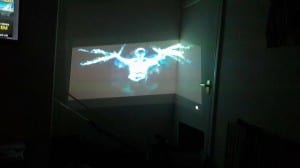After testing out the PicoPix, I tested a range of other desktop projectors in order to compare there effectiveness to the PicoPix.
An advantage of the PicoPix is its internal memory, meaning it doesn’t to have to be plugged into a source to work. The desktop projectors require a source to work. However, this gives them an advantage as it allows them to display a wider range of content, as it can display anything that is present on the source device. To use these projectors, the source, as well as the projector, will need to be hidden from the audience.
One main advantage of being connected to a source device is the ability to display live content, such as a video call. This is not possible on the smaller PicoPix.
However, unlike the PicoPix, the desktop projectors lack the ability to display sound. This means that the sounds will come from the projectors source. although this could be a disadvantage, a laptop source can connect to an external speaker, allowing the audio to come from closer to the final image output. By coming from the projector, the audio is coming from a different location to the final image. An external audio output will be more ideal, to keep the audio and visual elements together.
The size of the projectors make them harder to hide than the PicoPix, and they have large fans in order to keep them working over large periods of time, such as the final exhibition. The presence of these fans means it could be dangerous to cover the projectors, as this could result in over-heating. This will mean that the projectors will have to be integrated into the environment or left out in the open. Not hiding the projectors is a more ideal solution in the final exhibition, then covering them and risking them shutting off. Ensuring that the projectors work is the main priority, and hiding them comes second.

